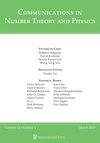The cosmic Galois group, the sunrise Feynman integral, and the relative completion of $\Gamma^1(6)$
IF 1.7
3区 数学
Q1 MATHEMATICS
引用次数: 0
Abstract
In the first part of this paper we study the coaction dual to the action of the cosmic Galois group on the motivic lift of the sunrise Feynman integral with generic masses and momenta, and we express its conjugates in terms of motivic lifts of Feynman integrals associated to related Feynman graphs. Only one of the conjugates of the motivic lift of the sunrise, other than itself, can be expressed in terms of motivic lifts of Feynman integrals of subquotient graphs. To relate the remaining conjugates to Feynman integrals we introduce a general tool: subdividing edges of a graph. We show that all motivic lifts of Feynman integrals associated to graphs obtained by subdividing edges from a graph $G$ are motivic periods of $G$ itself. This was conjectured by Brown in the case of graphs with no kinematic dependence. We also look at the single-valued periods associated to the functions on the motivic Galois group, i.e. the ‘de Rham periods’, which appear in the coaction on the sunrise, and show that they are generalisations of Brown’s non-holomorphic modular forms with two weights. In the second part of the paper we consider the relative completion of the torsor of paths on a modular curve and its periods, the theory of which is due to Brown and Hain. Brown studied the motivic periods of the relative completion of $\mathcal{M}_{1,1}$ with respect to the tangential basepoint at infinity, and we generalise this to the case of the torsor of paths on any modular curve. We apply this to reprove the claim that the sunrise Feynman integral in the equal-mass case can be expressed in terms of Eichler integrals, periods of the underlying elliptic curve defined by one of the associated graph hypersurfaces, and powers of $2\pi i$.宇宙伽罗瓦群、日出费曼积分和 $\Gamma^1(6)$ 的相对完备性
在本文的第一部分,我们研究了宇宙伽罗瓦群对具有一般质量和矩量的日出费曼积分的动机提升的作用的共轭,并用与相关费曼图相关的费曼积分的动机提升来表达它的共轭。除了日出的动机提升本身之外,只有一个日出的动机提升的共轭物可以用子方差图的费曼积分的动机提升来表示。为了将其余共轭与费曼积分联系起来,我们引入了一种通用工具:细分图的边。我们证明,通过细分图 $G$ 的边而得到的与图相关的费曼积分的所有动机提升都是 $G$ 本身的动机周期。这是布朗在没有运动依赖性的图形情况下提出的猜想。我们还研究了与动机伽罗瓦群上的函数相关联的单值周期,即 "de Rham 周期",这些周期出现在日出的协同作用中,并证明它们是布朗具有两个权重的非全形模形式的一般化。在论文的第二部分,我们考虑了模态曲线上路径的矢量的相对完备性及其周期,其理论归功于布朗和海恩。布朗研究了$\mathcal{M}_{1,1}$ 相对于无穷切向基点的相对完成的激励周期,我们将其推广到任意模态曲线上的路径背矢的情况。我们将其应用于证明等质量情况下的日出费曼积分可以用艾希勒积分、由相关图超曲面之一定义的底层椭圆曲线的周期以及 $2\pi i$ 的幂来表示。
本文章由计算机程序翻译,如有差异,请以英文原文为准。
求助全文
约1分钟内获得全文
求助全文
来源期刊

Communications in Number Theory and Physics
MATHEMATICS, APPLIED-MATHEMATICS
CiteScore
2.70
自引率
5.30%
发文量
8
审稿时长
>12 weeks
期刊介绍:
Focused on the applications of number theory in the broadest sense to theoretical physics. Offers a forum for communication among researchers in number theory and theoretical physics by publishing primarily research, review, and expository articles regarding the relationship and dynamics between the two fields.
 求助内容:
求助内容: 应助结果提醒方式:
应助结果提醒方式:


